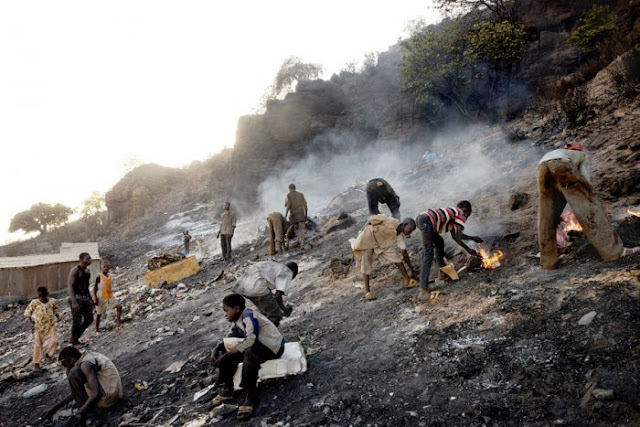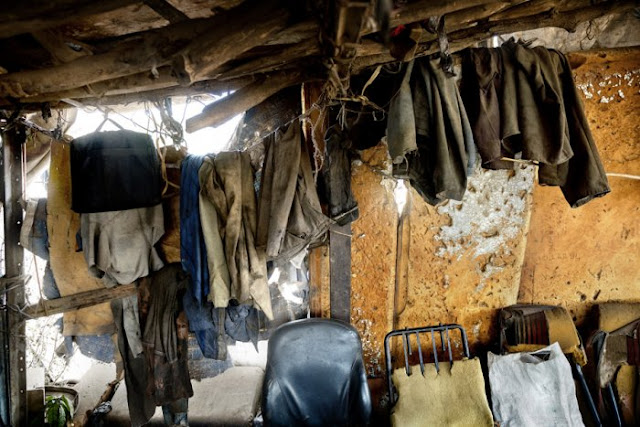Over the
last 15 years is rapidly manifesting a new scenario of contemporary slavery,
have spontaneously appeared new forms of slavery, which is no longer the
traffic of people to determine the status of a slave, but the total lack of
alternatives for sustaining the individual, to make that millions of people
choose to live on the margins of existence civil, employing themselves in
trades incredibly dangerous or harmful to their mental and physical health. Children
represent large amounts of this infernal process.
From the end of the last millennium, however, we are witnessing an unexpected and substantial return of slavery, although the definition of slavery involves numerous considerations, there are in fact the most varied forms of transition between ratios of simple relations of exploitation and a real enslavement but now in fact, millions of Africans live in human situations that can in effect be considered slavery.
In the world there are about 215 million children engaged in child labor, of these, more than 150 million are trapped in jobs that put at risk their physical and mental health, and condemn them to a life without education.
According to the ILO, 50%, or 74 million, is the number of children employed in various forms of unsafe work, such as working in mines, or in contact with chemicals or dangerous tools and machinery.
Sub-Saharan Africa is the region of the planet with the highest rate of child labor: more than a third of children aged 5 to 14 years is exploited in the most dangerous forms of work, physically, morally or mentally.
Mali is one of the poorest countries on the planet. The world's human development index, compiled by the United Nations, it is located on the 175th place out of 187 countries.
The industry is practically non-existent and the trade is mainly carried out in the informal sector, the spontaneous and occasional manifested in the streets, and wherever there is an opportunity to gain.
The government in Bamako recently approved a "National Plan for the elimination of child labor" under the policy of child protection. The objective of the Plan (Panetem) is to eradicate by 2020 forced child labor, considered a true form of slavery, but currently, there is no trace of such an initiative.
In the district of Medine in Mali's capital, Bamako, is located the oldest foundry of the city called Fantogò, which inherits its name from the mountain that hosts it. Its surface area is one hectare, half of which climbs up the adjacent mountain. From all over the country come here, recycled iron, which is then melted and forged for the production of professional hand tools, housewares, and other facilities. Iron processing is performed, starting from the day of birth of the foundry in 1996, with totally manual techniques.
Here employs more than 2000 people and, although there is no official census, the spontaneous and non-governmental committee that manages the foundry, estimates that about 900 workers, are children aged 9 to 17 years, the rest is made up of boys from 18 to 29 .
At least half of the workers in 2000, lives here and then at the end of their hellish work day, it remains within the slum, because it has its own abode.
Permission to sleep in the shacks, is the only form of remuneration for the street children who work in the foundry Fantogò, in addition to this, when possible, they are offered a daily meal that often consists of bread, biscuits or little else.
From the end of the last millennium, however, we are witnessing an unexpected and substantial return of slavery, although the definition of slavery involves numerous considerations, there are in fact the most varied forms of transition between ratios of simple relations of exploitation and a real enslavement but now in fact, millions of Africans live in human situations that can in effect be considered slavery.
In the world there are about 215 million children engaged in child labor, of these, more than 150 million are trapped in jobs that put at risk their physical and mental health, and condemn them to a life without education.
According to the ILO, 50%, or 74 million, is the number of children employed in various forms of unsafe work, such as working in mines, or in contact with chemicals or dangerous tools and machinery.
Sub-Saharan Africa is the region of the planet with the highest rate of child labor: more than a third of children aged 5 to 14 years is exploited in the most dangerous forms of work, physically, morally or mentally.
Mali is one of the poorest countries on the planet. The world's human development index, compiled by the United Nations, it is located on the 175th place out of 187 countries.
The industry is practically non-existent and the trade is mainly carried out in the informal sector, the spontaneous and occasional manifested in the streets, and wherever there is an opportunity to gain.
The government in Bamako recently approved a "National Plan for the elimination of child labor" under the policy of child protection. The objective of the Plan (Panetem) is to eradicate by 2020 forced child labor, considered a true form of slavery, but currently, there is no trace of such an initiative.
In the district of Medine in Mali's capital, Bamako, is located the oldest foundry of the city called Fantogò, which inherits its name from the mountain that hosts it. Its surface area is one hectare, half of which climbs up the adjacent mountain. From all over the country come here, recycled iron, which is then melted and forged for the production of professional hand tools, housewares, and other facilities. Iron processing is performed, starting from the day of birth of the foundry in 1996, with totally manual techniques.
Here employs more than 2000 people and, although there is no official census, the spontaneous and non-governmental committee that manages the foundry, estimates that about 900 workers, are children aged 9 to 17 years, the rest is made up of boys from 18 to 29 .
At least half of the workers in 2000, lives here and then at the end of their hellish work day, it remains within the slum, because it has its own abode.
Permission to sleep in the shacks, is the only form of remuneration for the street children who work in the foundry Fantogò, in addition to this, when possible, they are offered a daily meal that often consists of bread, biscuits or little else.
_______________________________________________________________________________________
Paolo Marchetti is a photojournalist based in Italy, Rome.
Paolo Marchetti is a photojournalist based in Italy, Rome.
He has worked for thirteen years
in the cinematographic and commercial industry, covering each role in the
Camera Dpt.
In his photography he pays
particular attention to political and anthropological issues. He has covered
stories in Brazil, Central America, Cuba, Eastern Europe, India, the United
States, Haiti, China, Central Africa, Colombia and Thailand.
His work has been published in
Italian magazines such as L'Espresso, Internazionale, Vanity Fair, Marie Claire
and many others, also in international magazines and newspapers such as 6MOIS,
Sunday Times, British Journal of Photojournalism, The Guardian, Geo, Days
Japan, Der Spiegel, Newsweek, CNN, New York Times, International Herald
Tribune, Time and many others.
Marchetti has received several awards including the The International Photography Award, Grand Prix de Paris and he was short listed for the Luis Valtuena International Humanitarian Photography Award. He has also been awarded five times with the NPPA - Best of Photojournalism, five times with the PDN’s Award, the Sony WPO Award, the Getty Images Editorial Photography 2012, in 2013 he was finalist at the Leica Oskar Barnack Award and between the 2013 and 2014 he has been recognized with four awards at the POY - Picture of the Year, two of which in the prestigious category "Photographer of the Year". Other awards are the American Photography Annual Book, the ANI Pix-Palace 2013 in Perpignan, the Leica Photographer Award 2013, the SDN - Social Documentary Network, the Days Japan, the Alexia Foundation Grant and the World Press Photo in "Nature" category and many others.
His long-term project, on
which he has been working for five years covering five different countries,
focuses on fascism and the awakening far-right in Europe and is titled
"FEVER".
All images ©
Paolo Marchetti



























Nessun commento:
Posta un commento